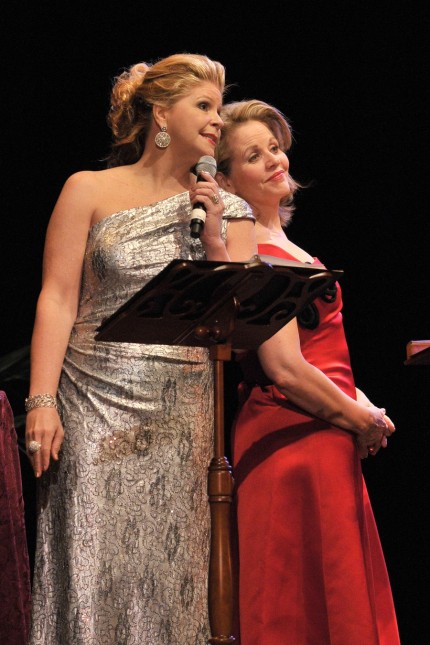Fleming and Graham team up for a beguiling homage to La belle époque

Susan Graham and Renée Fleming performed a French program Thursday night at the Civic Opera House in Chicago. Photo: Dan Rest
It’s hard to conceive of a more natural vocal partnership than soprano Renée Fleming and mezzo Susan Graham. The American superstars are of similar age and tastes, and their vocal profiles boast more similarities than differences. It’s fitting that the program for their six-city tour, presented in fabulous style Thursday night at the Lyric Opera of Chicago, emphasizes art song over opera, where competing styles can generate the sparks so essential to the dramatic stage.
Both have made French repertoire a focal point of their careers, and this wealth of experience and fluency bore handsome dividends. The guiding principal of their program is the celebration of the belle époque, the period around the turn of the 20th century during which the salon was the epicenter of French culture. Slides of French paintings and artist portraits were projected overhead, and the stage was tastefully adorned with potted plants, twin chandeliers, and ornate period music stands. Dark, understated gowns in the first half gave way to flashier couture after intermission (think silver Susan and red Renée).
No doubt a major draw of these Parisian affairs was the catty gossip and pithy bon mots tossed about between musical numbers, and the divas came ready with a wealth of period anecdotes, naught and otherwise. Their banter also served to illustrate the combustible partnerships of the programmed composers with their vocal muses, many of them American sopranos.
A trio of featherweight and stylishly turned Saint-Saéns duets opened the program before a set of works by Fauré began a move to more familiar repertoire. The various instrumental versions of the latter’s Pavane may be better known than this vocal duet, but the duo’s deft, pastel-hued delivery lent the popular tune a surprising measure of dramatic conflict. Tarantella showcased the singers’ formidable technique, complete with rapid-fire roulades tossed off with ease.
The duo dove into “Blanche-Marie et Marie-Blanche” from André Messager’s Les p’tites Michu with the giddy highjinks of teenage girls at a pajama party. At the opposite end of the musical spectrum, Berlioz’s La mort d’Ophélie was a searing, darkly-hued portrait of love gone tragically awry.
Pianist Bradley Moore was their sensitive accompanist as well as soloist in a lithe, poetic account of Debussy’s evergreen Clair de lune. Even with exaggerated tempo shifts and a barely audible left hand (an acoustical quirk of the hall), the shapely reading held many delights.
As delightful as the duos were, many of the most memorable highlights came in the solo songs, where the constraints of uniformity gave way to more personalized and heartfelt readings. Fleming’s account of Debussy’s Mandoline was utterly beguiling, and one could sense the audience holding it’s collective breath during the same composer’s Beau Soir, so keen were they to soak up every hushed nuance.
Amidst the parade of standards by the top rank of French composers, it was refreshing to hear Graham earnestly plug the lesser-known Reynaldo Hahn. Not all will share her enthusiasm for his well-crafted but single-dimensional songs, but Graham’s illuminating delivery of the texts by Paul Verlaine and other poets was entrancing. Her fans will long remember her slow, seductive entrance, cigarette dangling, for a tantalizing encore of the Edith Piaf standard La Vie en Rose by Monnot and Guglielmi, ably accompanying herself on the concert grand.
Other encores included perfectly groomed duets from Mozart’s Cosí fan tutte (“Ah, guarda sorella”) and Humperdinck’s Hansel and Gretel. Given the evening’s emphasis on intimacy over fireworks, the latter’s “Evening Prayer” was especially fitting.